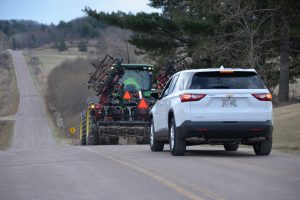Contact: Cheryl Skjolaas, 608-265-0568, skjolaas@wisc.edu
 If you’re heading out to the rural areas to pick pumpkins and apples or check out the fall colors, you’re likely to encounter slow moving farm equipment on the road as fall harvest season is underway throughout the state. That means it’s time for all drivers to be especially aware of farm equipment and slow down when encountering slow moving farm equipment.
If you’re heading out to the rural areas to pick pumpkins and apples or check out the fall colors, you’re likely to encounter slow moving farm equipment on the road as fall harvest season is underway throughout the state. That means it’s time for all drivers to be especially aware of farm equipment and slow down when encountering slow moving farm equipment.
“Farm equipment is big, slow and not very maneuverable, it doesn’t behave like cars and trucks when it comes to speed, turning or braking,” said Cheryl Skjolaas, agricultural safety specialist in the University of Wisconsin-Madison Division of Extension and the College of Agricultural and Life Sciences. “Its size makes it hard to move over quickly and it will take longer for it to turn into driveways or intersections. It is also difficult for the farm implement operator to see other vehicles that are following or passing farm equipment.”
The combination of slow traveling farm equipment and faster motor vehicles means the time before the two meet can be seconds. Most farm equipment is operating at speeds under 25 mph. A motor vehicle coming up behind a farm implement has only seconds to stop before a crash may occur. Any type of distracted driving – talking on cellphone, checking a text message, being tired- can make stopping without a crash almost impossible.
Skjolaas, UW Center for Agricultural Safety and Health outreach specialist said, “For the motorists, we really want you to be taking your time, looking up the road a distance for that slow moving farm machinery and when you see something in the distance, start slowing down because if that equipment is operating 15 miles per hour and you’re traveling 55 miles per hour, we’re talking in 300 feet you have like 3 seconds to be slowing down.”
Slower speeds also mean that motorists are going to be tempted to pass farm implements. Skjolaas reminds motorists that it is illegal to pass a farm implement or an agricultural commercial motor vehicle in a no passing zone.
A motorist always has the responsibility to make sure that there’s a safe passing distance; making the decision to pass is difficult with farm implements. Look at those passing zones where you can legally pass the farm equipment, but still, really make that determination that you have enough distance to pass that farm equipment, that there’s enough width to the roadway that you can safely get around that farm equipment and if you’re approaching a controlled intersection – one that has stop signs or stoplights – that you’re going to be able to give that operator of that farm equipment time enough to stop.
Skjolaas offered some tips and reminders for motorists during the fall harvest season:
– Look for lighting and marking on the farm implements. Farm machinery that usually travels less than 25 miles per hour (mph) is required to display a ‘slow moving vehicle’ or SMV emblem on the back. It is an orange and red triangle visible to the rear on either the left hand side of the tractor or towing implement or the rear most towed vehicle. This is a key marking that a driver is approaching a farm implement.
– Keep a safe distance back. The farm vehicle operator may not be able to see around the equipment, so don’t assume that the operator knows you are approaching. Similar to semi-trucks, many use large extended mirrors. When a driver follows too closely, the vehicle isn’t visible to the farm equipment operator.
– Check for turn signals. On farm tractors or self-propelled machines like combines, the flashing lights are also turn signals. When following slow moving machines for a distance, it is easy to miss that operator has signaled for a turn. Or watch for the operator to use a hand signal when signal lights are not present.
– During hours of darkness and low light situations when visibility is less than 500 feet such as when foggy or raining, everyone should have headlights on.
– Farm implements may be traveling on roads where they are normally not expected For example, farmers may use local streets or highways to transport grain to storage facilities.
– A road sign to watch for is a yellow and black warning sign with the symbol of a farmer driving a tractor. These signs are within 500 feet of a driveway to alert motorists of a farm or field drive with an obstructed view such as on a hill or around a curve.



